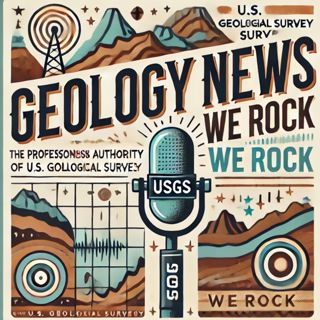
Detailed Geological Mapping: USGS Helicopter Flights to Enhance Understanding of Montana and Idaho Landscapes
The United States Geological Survey (USGS) is set to conduct a series of low-level helicopter flights over select regions of Montana and Idaho to capture detailed images of the area's geology. This initiative, undertaken in full compliance with Federal Aviation Administration (FAA) regulations, aims to enhance our understanding of geological formations and processes in these states. The helicopter flights will utilize advanced imaging technology to gather high-resolution data, offering insights that could benefit a range of studies and applications, from natural resource management to environmental protection. These flights will be conducted at low altitudes to ensure the precision and quality of the geological imaging.The USGS emphasizes the importance of this project for both scientific research and public welfare. Detailed geological data is crucial for tasks such as earthquake hazard assessment, groundwater resource management, and mineral exploration. By mapping and analyzing geological features, the USGS can provide valuable information that helps safeguard communities and supports sustainable development.Local communities in the flight areas may notice the helicopters operating at reduced altitudes. The USGS assures the public that every measure has been taken to minimize disruption and maintain safety throughout the operation. The gathered data will contribute significantly to the national geological database, supporting future research and policy-making efforts.The USGS appreciates the cooperation of local communities in Montana and Idaho during this project. Public awareness and support are vital for the successful execution of these flights, which play a crucial role in advancing our geological knowledge and preparedness for natural events.This content was created in partnership and with the help of Artificial Intelligence AI
11 Aug 20242min

27 Years Since Groundbreaking Mars Pathfinder Mission Paved the Way for Rover Exploration
This month marks 27 years since the successful landing of NASA’s Mars Pathfinder spacecraft, including Sojourner, the first-ever robotic rover to land on Mars. The Mars Pathfinder mission, launched on December 4, 1996, and landing on July 4, 1997, at Ares Vallis, signified a monumental leap in space exploration and robotics.The mission's primary objective was to demonstrate a low-cost method for delivering a set of scientific instruments to the Martian surface. It comprised a lander, later named the Carl Sagan Memorial Station, and a lightweight, six-wheeled robotic rover called Sojourner. The Pathfinder was an engineering marvel, designed to test various intriguing mechanisms, such as airbags for the lander to cushion its landing—a novel approach never before attempted in planetary exploration.Upon landing, Sojourner became the first rover to traverse the surface of Mars, transforming how scientists could study the Martian environment. Though diminutive in size—about 65 centimeters long and weighing just 11.5 kilograms—its impact on Mars exploration was colossal. Equipped with an array of scientific instruments, Sojourner analyzed the composition of Martian rocks and soil, offering invaluable insight.The data beamed back to Earth revealed more about Mars's atmospheric conditions, climate history, geology, and the presence of water. Sojourner captured numerous images, and its analyses suggested that Mars could have supported liquid water in the past, laying the groundwork for subsequent missions aimed at uncovering the planet's habitability.Mars Pathfinder and Sojourner's achievements transcended technical frontiers. The mission captivated public interest globally, showing that space exploration was no longer the exclusive domain of scientists. Its successes inspired educational initiatives and stimulated imagination, signaling a new era where sophisticated robotics could autonomously explore other planets.Despite its initial mission design term of just seven days, Sojourner lasted an impressive 83 days before communication ceased on September 27, 1997. During this brief yet fruitful period, the rover relayed critical scientific data and imagery, far exceeding expectations.As a trailblazer, Sojourner's legacy is reflected in the design and success of subsequent Mars rovers like Spirit, Opportunity, Curiosity, and Perseverance. Each of these rovers has built upon Sojourner’s pioneering blueprint, exploring more complex terrains, analyzing more intricate geochemical compositions, and pushing deeper into Mars's ancient secrets.Reflecting on this historic milestone, we honor the engineers, scientists, and visionaries who made this mission possible. Mars Pathfinder and Sojourner’s triumphs serve as enduring reminders of human ingenuity and the relentless pursuit of knowledge beyond our home planet.This content was created in partnership and with the help of Artificial Intelligence AI
7 Aug 20243min

27 Years After Historic Mars Pathfinder Landing, Lessons for Future Space Exploration
This month marks 27 years since the successful landing of NASA’s Mars Pathfinder spacecraft, along with Sojourner, the first-ever robotic rover to explore the Martian surface. The mission was a landmark achievement in space exploration, providing unprecedented insights into the Red Planet's geology and environment.Launched on December 4, 1996, Mars Pathfinder embarked on a seven-month journey to Mars, culminating in its historic landing on July 4, 1997. The mission's primary objective was to demonstrate the feasibility of low-cost landings on and exploration of the Martian surface. By achieving this, it paved the way for a series of subsequent missions that have deepened our understanding of Mars.Sojourner, the star of the mission, was a six-wheeled robotic rover equipped with scientific instruments, including cameras and spectrometers, to analyze the Martian terrain. Weighing just 23 pounds, the rover was remarkably compact yet capable of performing complex tasks. Sojourner's findings included images and data that suggested the presence of past water activity on Mars—an essential clue in the quest to determine the planet's potential for harboring life.The mission exceeded all expectations. Originally planned to last only seven days, Sojourner roved the Martian surface for an impressive 83 days, traveling over 330 feet and conducting various scientific experiments. Among its accomplishments was the analysis of rocks and soil, providing essential data that spurred further exploration missions like the Mars Exploration Rovers, Spirit and Opportunity, and more recently, the Curiosity and Perseverance rovers.Mars Pathfinder and Sojourner revolutionized space exploration by utilizing new methods that significantly reduced mission costs. The entire project, including the construction, launch, and operation, was executed on a budget of only $280 million—remarkably economical by space mission standards. This cost efficiency demonstrated that ambitious planetary exploration could be achieved without exorbitant expenses, inspiring future missions and international collaborations.In addition to its scientific contributions, Mars Pathfinder captured the public's imagination. The mission's success was widely covered by media outlets, and the images sent back by Sojourner were viewed worldwide, fostering a greater public interest in space exploration. The mission is credited with rekindling enthusiasm for Mars exploration, a sentiment that continues to flourish today.Sojourner's legacy endures not only through the wealth of scientific knowledge it provided but also as a pioneering force in robotic exploration. Subsequent rovers have built upon its technological foundation, incorporating advanced features like autonomous navigation and sophisticated analytical tools.As we commemorate the 27th anniversary of this remarkable mission, it serves as a reminder of the ingenuity, perseverance, and collaborative spirit that drive human exploration. Mars Pathfinder and Sojourner exemplify the boundless potential of space missions to expand our understanding of the cosmos, paving the way for future explorers to uncover the mysteries of our neighboring planets.This content was created in partnership and with the help of Artificial Intelligence AI
4 Aug 20243min

Celebrating 27 Years of NASA's Groundbreaking Mars Pathfinder Mission and the Trailblazing Sojourner Rover
This month marks 27 years since the successful landing of NASA’s Mars Pathfinder mission, which included Sojourner, the first-ever robotic rover to explore the Martian surface. The Pathfinder mission, a groundbreaking endeavor in space exploration, was launched on December 4, 1996, and successfully landed on Mars on July 4, 1997.NASA’s innovative approach to the Pathfinder mission combined a stationary lander with the mobility of Sojourner, a small but robust rover designed to traverse and study the Martian terrain. This dual-component system allowed scientists to gather a broader array of data than stationary landers had previously achieved.Sojourner, named after the American civil rights activist Sojourner Truth, was a technological marvel of its time. Equipped with scientific instruments, cameras, and sensors, it roamed the Martian surface for 83 days, exceeding its planned mission duration of seven days. During its operational period, Sojourner sent back more than 550 images and performed various experiments. These contributions significantly advanced our understanding of Mars' geology, atmosphere, and potential for past life.The Pathfinder mission as a whole provided invaluable insights into the Red Planet. The lander itself, later named the Carl Sagan Memorial Station, conducted numerous experiments and sent back panoramic images and weather data. Pathfinder’s success demonstrated the feasibility of delivering and operating a rover on another planet, paving the way for future missions.Sojourner's legacy endures as a testament to human ingenuity and the relentless quest for knowledge. It set the stage for subsequent Mars rovers such as Spirit, Opportunity, Curiosity, and Perseverance, each building on the foundation laid by Pathfinder and Sojourner. As we commemorate this 27th anniversary, we celebrate a milestone that opened new frontiers in our exploration of the cosmos.This content was created in partnership and with the help of Artificial Intelligence AI
31 Juli 20242min

Unlocking Global Mineral Insights: Major Database Expansion Fuels Sustainable Mining Innovations
The geological surveys of the U.S., Australia, and Canada are unveiling major updates to a shared database on mineral ores. These updates substantially expand the database from 7,300 to more than 25,000 samples. Alongside this growth, new criteria and a formalized process have been introduced, allowing any organization to contribute ore samples.This collective effort aims to provide powerful insights into valuable byproduct minerals. The increase in sample size and democratized contribution process enhance the robustness and comprehensiveness of the database, ensuring a more detailed and accurate mapping of mineral resources.By integrating such a wide array of data, geologists and researchers can more effectively analyze mineral compositions, discover new extraction methods, and increase the efficiency of mining operations. This expansion also facilitates international cooperation and knowledge sharing, which are critical in addressing global challenges such as resource scarcity and sustainable development in the mining industry.Overall, the updates to this international mineral ores database mark a significant leap forward in geological research, offering a richer resource for scientists and industry experts worldwide.This content was created in partnership and with the help of Artificial Intelligence AI
28 Juli 20241min

Expanded Global Mineral Database Empowers Sustainable Mining Practices
The geological surveys of the U.S., Australia, and Canada have announced significant updates to a shared database on mineral ores, expanding its repository from 7,300 to over 25,000 samples. This extensive upgrade is accompanied by the introduction of new criteria and a formalized process, enabling a broader range of organizations to contribute ore samples. The collaborative effort aims to provide richer and more comprehensive insights on valuable byproduct minerals, which are often found alongside primary mined materials.The enhanced database is expected to serve as a critical resource for scientists, mining companies, and policymakers. By facilitating easier access to a more extensive array of samples, it allows for more accurate assessments of mineral composition, potential byproduct extraction, and the economic viability of mining projects. The updates also support sustainable mining practices by helping identify opportunities to recover valuable secondary minerals that might otherwise be discarded as waste.Moreover, the inclusion of diverse data contributed by multiple organizations ensures a more standardized and comprehensive collection of information. This will likely lead to improved predictive models for mineral discovery and extraction, potentially reducing costs and enhancing efficiency in the mining industry.In summary, these updates represent a significant advancement in the field of mineralogy, fostering international collaboration and enhancing our understanding of valuable byproduct minerals.This content was created in partnership and with the help of Artificial Intelligence AI
24 Juli 20242min

International Geological Surveys Expand Mineral Ore Database, Unlocking Insights for Sustainable Mining
The international geological surveys of the U.S., Australia, and Canada have released significant updates to their shared database on mineral ores, a move set to provide powerful insights into valuable byproduct minerals. What was once a repository of 7,300 samples has now expanded dramatically to encompass more than 25,000 samples. This major enhancement is not merely quantitative; it also includes the introduction of new criteria and the establishment of a formal process that enables any organization to contribute ore samples to the database.The expansion of the database represents a substantial leap forward in the field of geology and mineral exploration. The increased volume of samples offers a much richer dataset that promises to be a treasure trove of information for miners, researchers, and policy-makers. This comprehensive collection enables more accurate mapping of mineral resources, helps predict geological trends, and facilitates the discovery of previously overlooked byproducts that can be economically valuable.The new criteria introduced for sample inclusion ensure that the data maintained in the database is of the highest quality and relevance. This rigorous vetting process aims to standardize the type of information collected, including data points such as mineral composition, geolocation, and extraction methods. Such standardization is critical for meaningful comparisons and advanced analytical techniques, such as machine learning and predictive modeling.Perhaps the most groundbreaking aspect of these updates is the establishment of a formal process that welcomes contributions from any organization. This inclusive approach democratizes access to the database and encourages a wide range of stakeholders to participate. Universities, private companies, and other governmental agencies can now submit their own ore samples. This broadened participation is likely to diversify the types of minerals and geographic areas represented in the database, thereby enhancing its utility and comprehensiveness.In addition, this open contribution model fosters a collaborative environment that could accelerate scientific breakthroughs and technological advancements in mineral extraction and processing. The collective effort can lead to innovative solutions for sustainable mining practices, reducing environmental impact while maximizing the economic benefits of mineral resources.The expanded database and its new contribution framework could also have far-reaching implications for international trade and economic development. As countries look to secure reliable sources of essential and precious minerals, the enriched database could serve as a vital tool in navigating supply chains and mitigating geopolitical risks associated with critical mineral dependencies.In conclusion, the updates to the international mineral ore database by the geological surveys of the U.S., Australia, and Canada mark a significant milestone in the realm of geological research and mineral exploration. The dramatic increase in sample volume, coupled with new quality criteria and an inclusive contribution process, sets the stage for unprecedented insights and advancements. Researchers, industry professionals, and policymakers stand to benefit enormously from this enhanced resource, which promises to inform and drive the future of sustainable and efficient mineral exploitation.This content was created in partnership and with the help of Artificial Intelligence AI
22 Juli 20243min





















